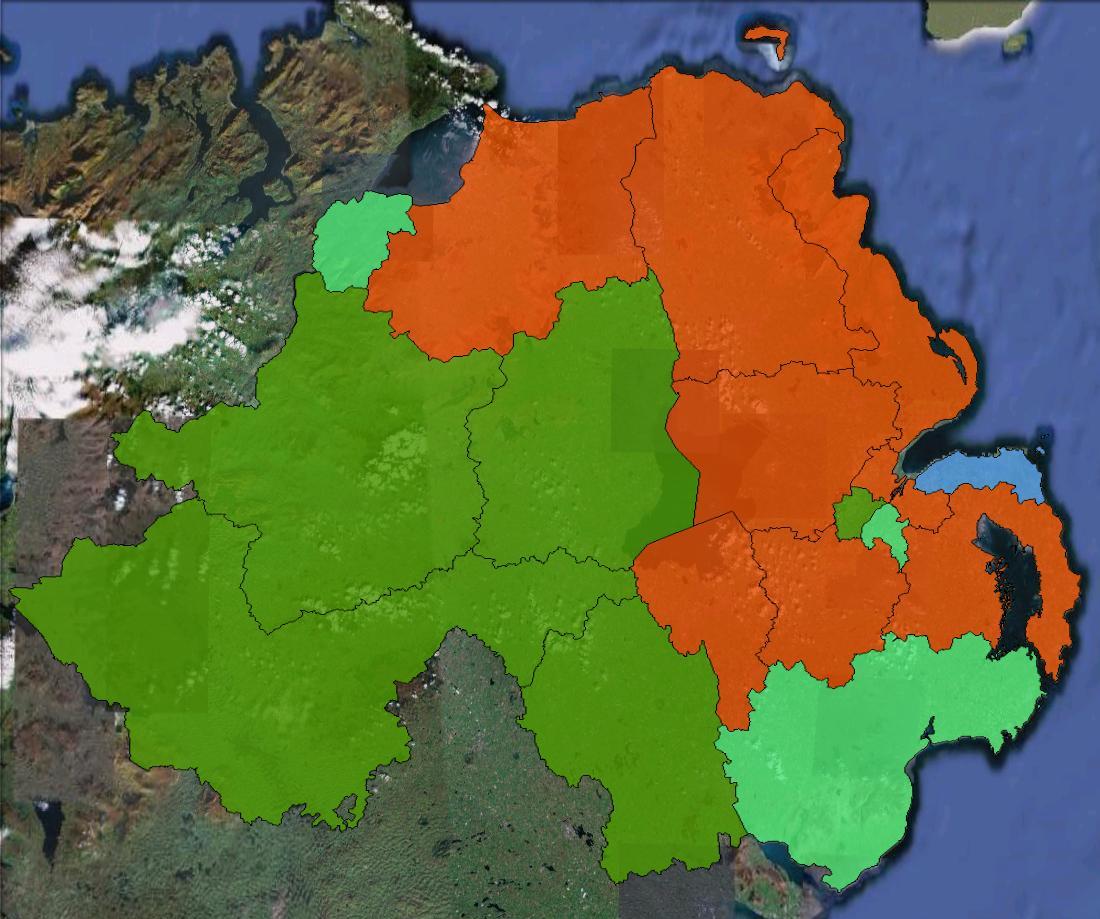Political events in Northern Ireland in recent days suggest that an election for the Legislative Assembly may loom in the next few months, while the election for Northern Ireland’s 18 seats in the House of Commons may gain extra significance at the upcoming UK election.
The current Northern Ireland Executive is at risk of collapsing, as Northern Ireland’s two largest parties have failed to agree on the devolution of police and justice powers to the Northern Ireland Executive.
Northern Ireland is governed by a unique political structure where the four largest political parties all take ministries in the government, sharing power between nationalist parties and unionist parties. The government is headed by First Minister Peter Robinson of the Democratic Unionist Party and Deputy First Minister Martin McGuinness of Sinn Fein. The DUP and Sinn Fein are joined by the more moderate Ulster Unionist Party and Social Democratic and Labour Party around the Cabinet table.
Northern Ireland was previously governed by a more moderate coalition led by the UUP and SDLP from 1999 until 2002, but the 2003 election saw both parties overtaken by their respective rivals. The current coalition took office in 2007, and the 2007 election reaffirmed the 2003 result with the DUP and Sinn Fein as the largest parties.
Negotiations over policing and justice powers have continued for months, with Sinn Fein wanting to see the Northern Ireland government take on authority, while Unionists supported a delay. In recent days this has reached a crescendo with Sinn Fein threatening to resign from the Executive, which would trigger an early Legislative Assembly election. British Prime Minister Gordon Brown and Irish Taoiseach Brian Cowen have cleared their schedules for talks to keep both sides at the table.
The state of Northern Ireland politics is very unclear at the moment, and an election could have dramatic consequences. Sinn Fein president Gerry Adams has recently been battered by allegations of sexual abuse against his brother, while the SDLP is in the process of electing a new leader. DUP leader Peter Robinson recently stepped down temporarily as First Minister after his wife Iris resigned as a member of the House of Commons and Legislative Assembly over financial and sexual scandals. The DUP is also facing a challenge from the far-right Traditional Unionist Voice, which is pressuring the DUP from the right over its cooperation with Sinn Fein in the devolved government. With the prospects of the DUP losing grounds to both the moderate Ulster Unionists and the extremist Traditional Unionists, there has been speculation that Sinn Fein could become the single largest party at Stormont, despite unionist parties winning a majority in Parliament.

While there is a chance that an election will be held for the Legislative Assembly, there will definitely be an election for Northern Ireland’s 18 seats in the UK House of Commons. The 2005 election saw the UUP lose five of their seats, with the DUP winning nine, Sinn Fein five, SDLP three and only one seat being won by the UUP.
Usually Northern Ireland seats don’t play a significant role in UK elections. Labour, the Conservatives and the Liberal Democrats traditionally don’t run in Northern Ireland, and there are a small number of seats. Sinn Fein do not take their seats in Parliament, and most elections produce majorities large enough to make the other parties irrelevant.
In 2010, the Conservatives will need a large lead in order to win a majority in Parliament, which is raising the prospect of a hung parliament. Presumably this has motivated recent moves by the Conservatives to lock in the support of unionist parties in Northern Ireland, who could command as many as twelve seats after this year’s election.
David Cameron has already agreed to an electoral pact with the UUP, whereby the two parties would support a single candidate in each constituency. Reports have recently emerged of talks between Conservative shadow Northern Ireland secretary Owen Paterson and representatives of both the DUP and UUP earlier in January, raising the prospect of the parties developing closer links to the Conservatives, which could have serious implications for the Northern Ireland peace process under a British government openly aligned with protestant unionism.
These moves have resulted in a number of prospective Conservative candidates in Northern Ireland resigning over the prospect of an alliance with the DUP. It certainly appears that Northern Irish politics will be very interesting over the coming months.



Ben, you say that “Labour, the Conservatives and the Liberal Democrats traditionally don’t run in Northern Ireland”, but then at the end talk about “prospective Conservative candidates in Northern Ireland” – does that mean that the Conservatives are breaking with tradition and running HOC candidates in Northern Ireland this year?
Yes, I think so. But they are doing it as part of an electoral pact with the UUP. The Labour Party has also set up a branch in Northern Ireland but I don’t know if they plan to stand candidates in 2010. I think the Liberal Democrats have an alliance with the Alliance Party, the largest non-sectarian party in the Assembly.
And noting that other parties DO stand – the NI Greens have 1 seat in the Assembly, and the UKIP also stood last time. Indeed, given the nature of the power sharing arrangements for Government, the only non-Government parties are the Alliance, Greens, PUP and an independent – a total of 10 seats out 108.
The Conservatives DO stand in NI as well – they used to be allied with the UUP in Westminster, but that ended in 1972 with the Sunningdale Agreement, and since the 19990s the Conservatives do run a few candidates – polling between 0.5% and 2% in the constituencies. They got 0.5% in the 2007 elections, and rejoined the UUP for the Euros.
Labour doesn’t stand, and the SDLP is probably the closest to Labour and they’ve cooperated somewhat. The Alliance is closest to the LibDems, and I’m pretty sure they cooperate(d) as well.
Comments are closed.